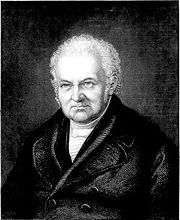J A Schubert 1800 - 1868
March 01, 2009
 J A Schubert 1800? - 1868? was an Austrian
orthodox physician who converted to homeopathy to become a
student
of Samuel Hahnemann in
Leipsig.
J A Schubert 1800? - 1868? was an Austrian
orthodox physician who converted to homeopathy to become a
student
of Samuel Hahnemann in
Leipsig.
Schubert was the homeopath of Anton Philipp Reclam and his daughter,
Schubert attended the Homeopathic Congress in Leipsig in 1832, and he was a member of the Central Association of Homeopaths in Leipsig, alongside Albrecht, Baumann, Ernst von Brunnow, Pierre Dufresne, Jean Barthelemy Arles Dufour, Anton Fischer, Carl Franz, Gaumann, Gustav Wilhelm Gross, Comte Sebastien Gaeten Salvador Maxime Des Guidi, Carl Georg Christian Hartlaub, Frantz Hartmann, Carl Haubold, Hofrath, Kretschmar, Kruger Hansen, William Leaf, Johan Joseph Wilhelm Lux, Moritz Wilhelm Mueller, Georg August Heinrich Muhlenbein, Charles Gaspard Peschier, Frederick Hervey Foster Quin, Gottlieb Martin Wilhelm Ludwig Rau, Rohl, Mathias Roth, Ernst Ferdinand Rueckert, Rummel, John Ernst Stapf, Suffert, Timotheus Samuel Thorer, Karl Friedrich Gottfried Trinks, George Adolph Weber, Friedrich Wolf, Paul Wolf, and many others.
Schubert practiced in Dramberg.
Schubert experimented with innoculation in 1853, producing an itch after innoculating prurulent matter, and he treated Cholera homeopathically in 1830.
Schubert contributed articles and cases to various homeopathic publications.
Of interest:
 Gotthilf
Heinrich von
Schubert
1780 - 1860 was a German doctor, natural scientist and natural
philosopher of Romanticism.
Gotthilf
Heinrich von
Schubert
1780 - 1860 was a German doctor, natural scientist and natural
philosopher of Romanticism.
Gotthilf Henrich von Schubert was a teacher of homeopath William Wesselhoeft.
Gotthilf Henrich von Schubert wrote The History of the Soul, and he investigated the Seeress of Provost with Justinus Kerner:
Frederica Hauffe, better known as the “Seeress of Provost,” was a somnambule who came under the observation of Justinus Kerner, a well known poet and physician, early in the nineteenth century.
A natural trance and convulsive patient, she came to Justinus Kerner to be magnetised, but he endeavoured at first to treat her by medicinal means. Finding these unavailing, however, he resorted to magnetism. Henceforward the Seeress passed the greater part of her life in trance, displaying all the usual somnambulic phenomena.
She saw and conversed with apparitions, developed remarkable clairvoyant faculties, and dealt also in mysticism, describing intricate symbolical circle systems. She was also the author of a “primitive” language, constructed with some ingenuity, which purported to be that tongue, spoken by the patriarchs of old, wherein the words conveyed in some mystic manner the properties of the things they designated.
Justinus Kerner and others were sometimes able to see Frau Hauffe’s ghostly interlocutors, as dim grey pillars of cloud. Physical phenomena of a poltergeistic character were also of common occurrence in her presence.
Justinus Kerner dedicated his book on The Seeress of Provost to Gotthilf Henrich von Schubert.